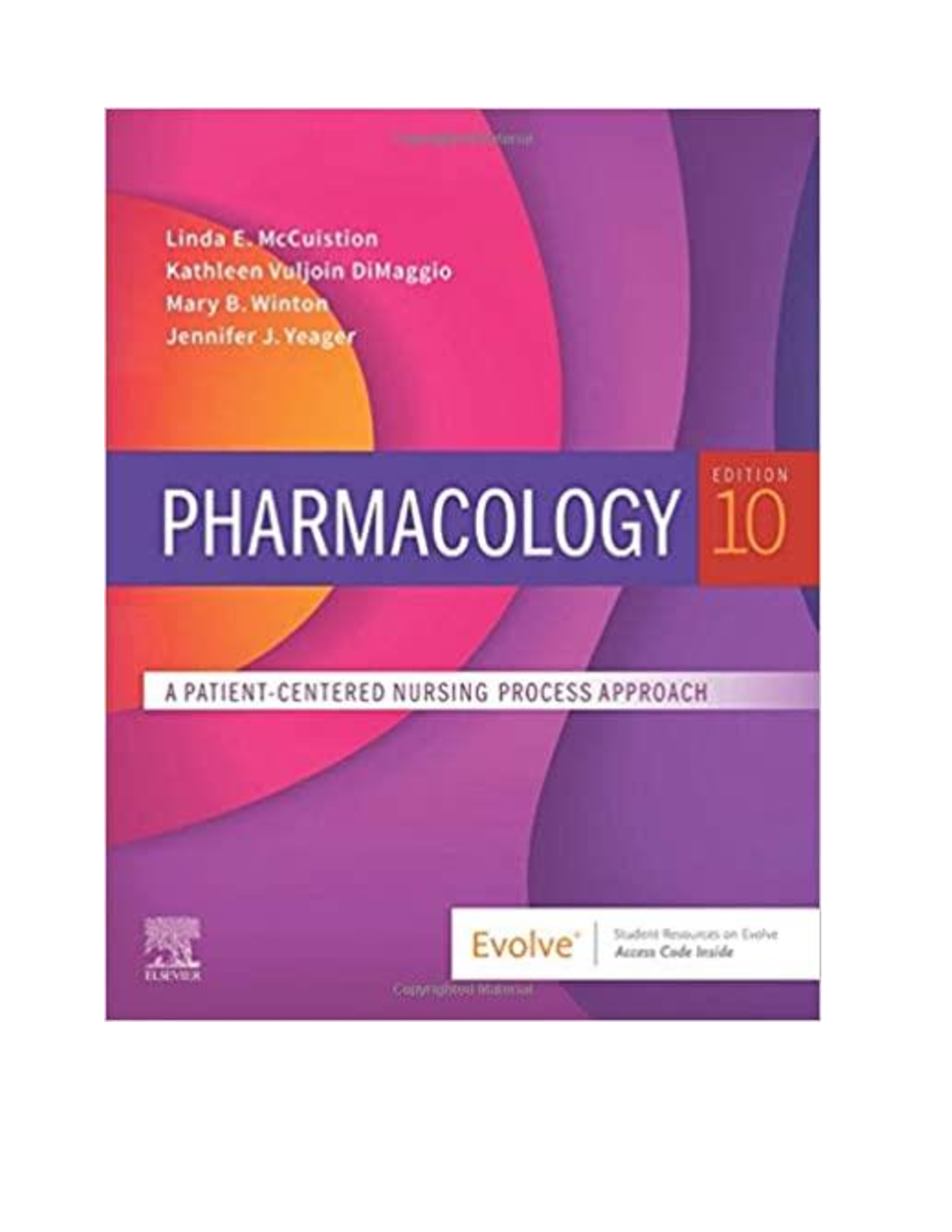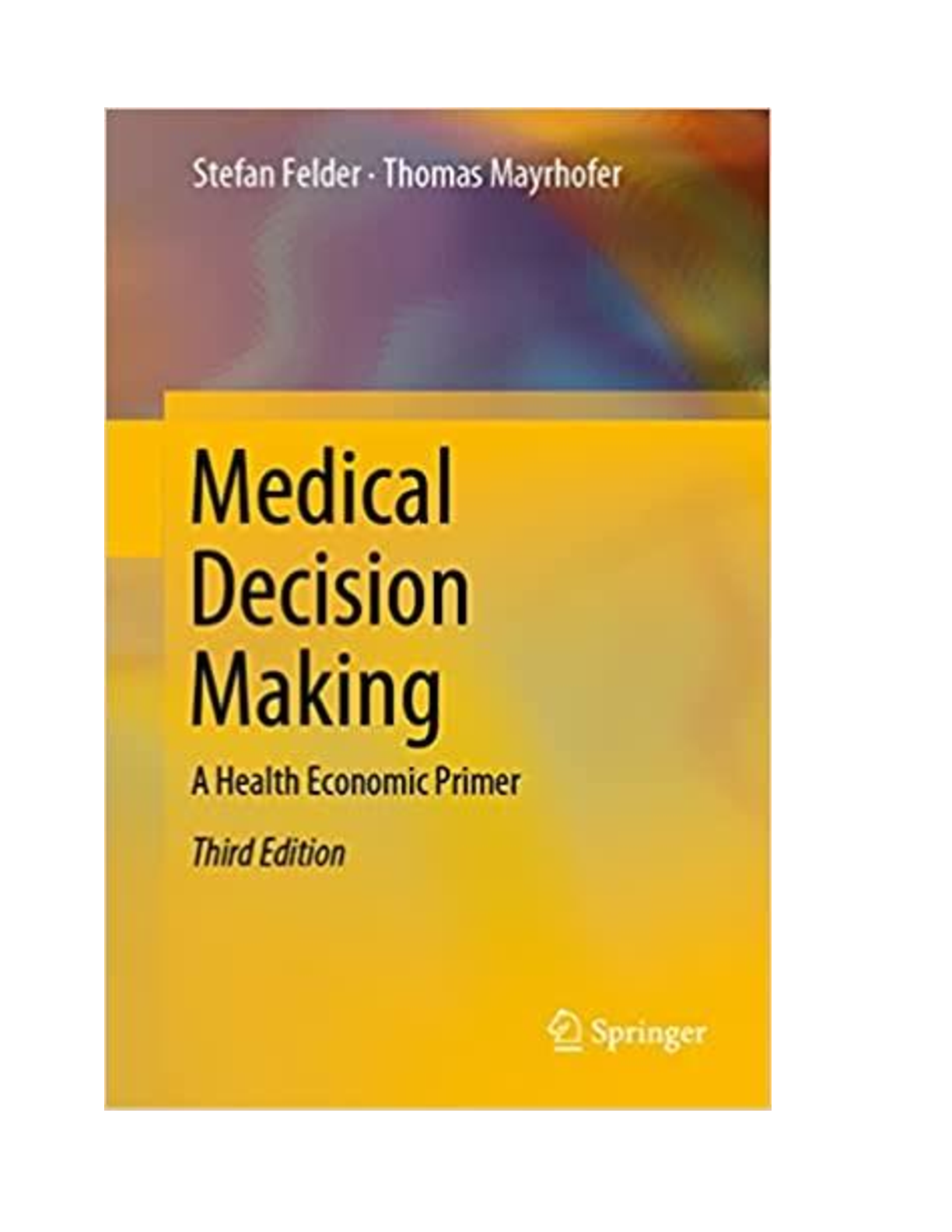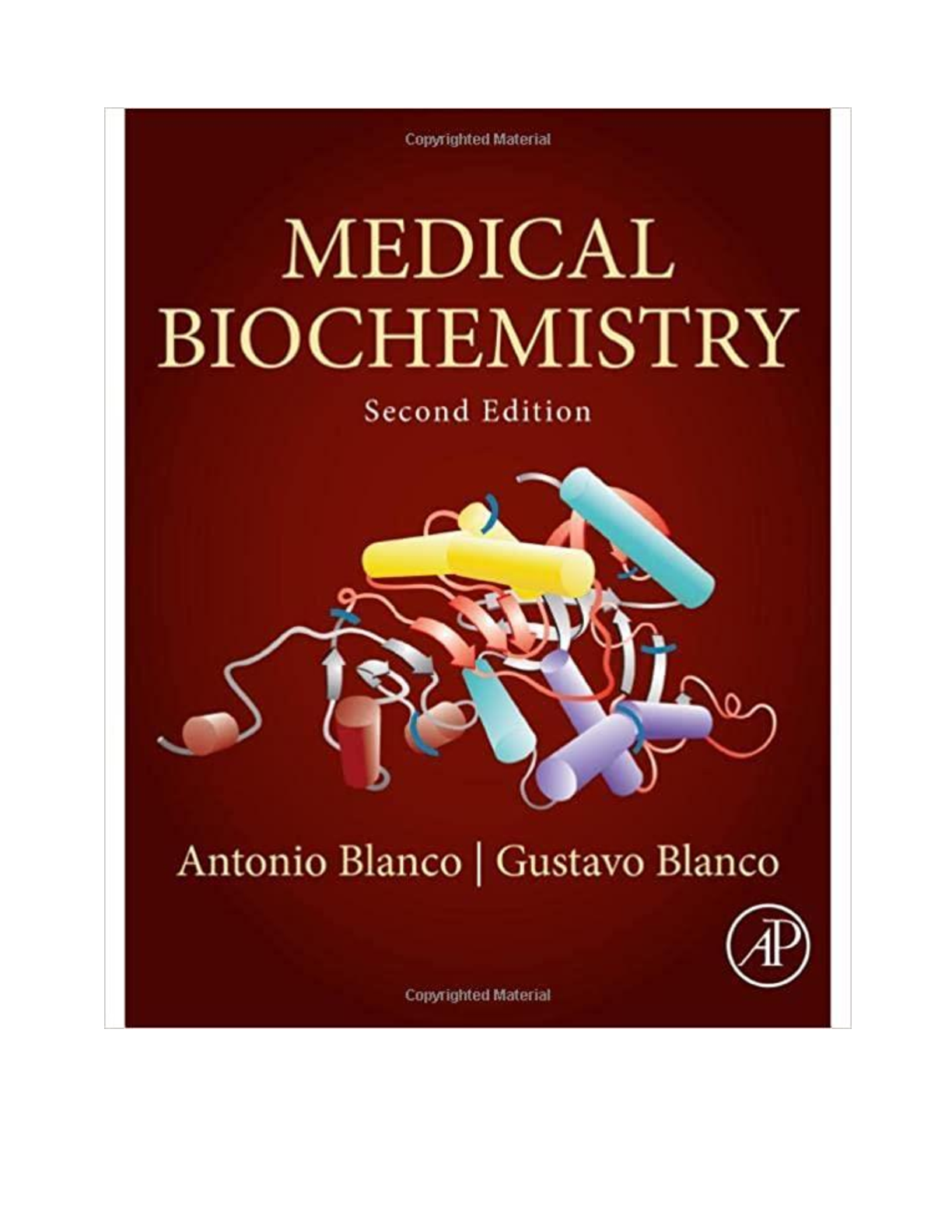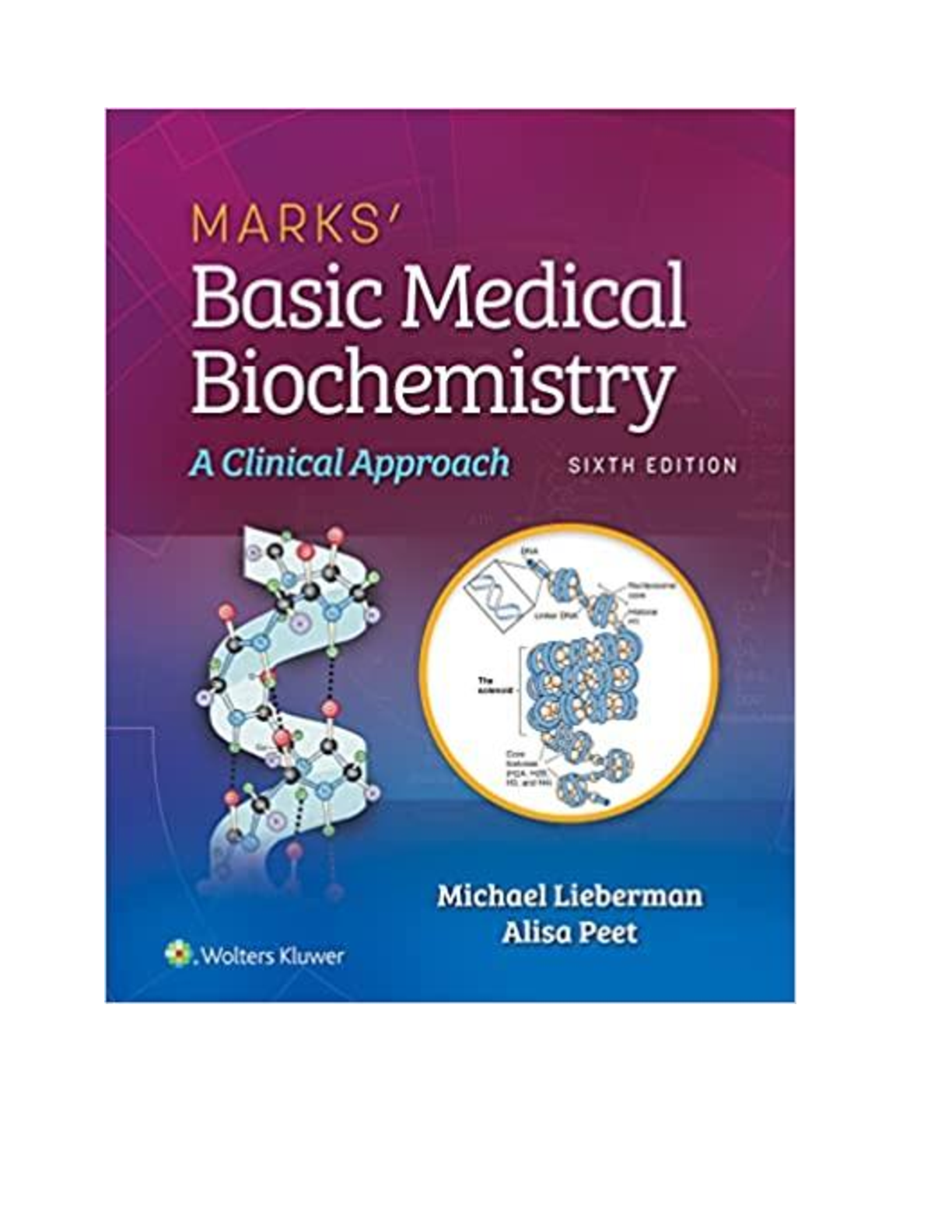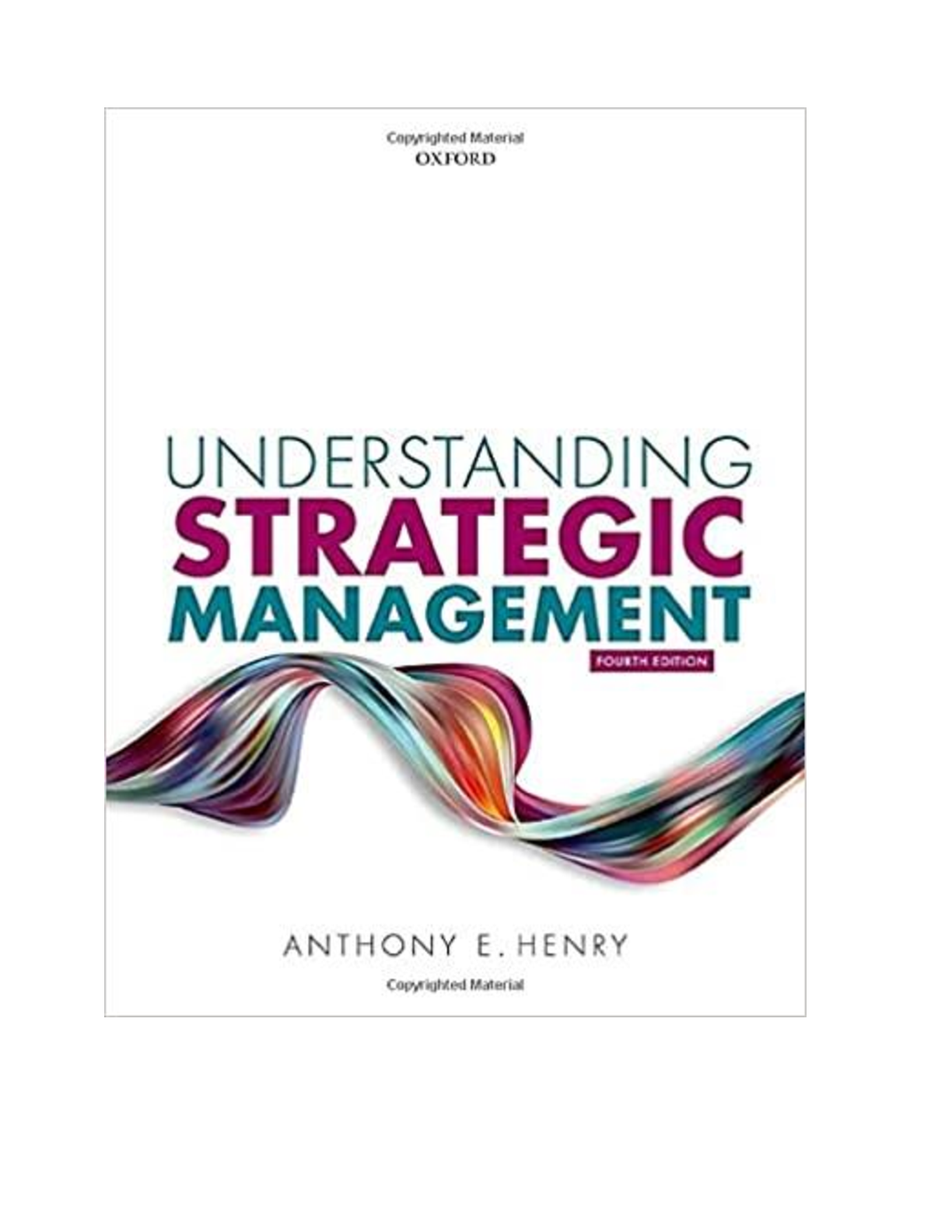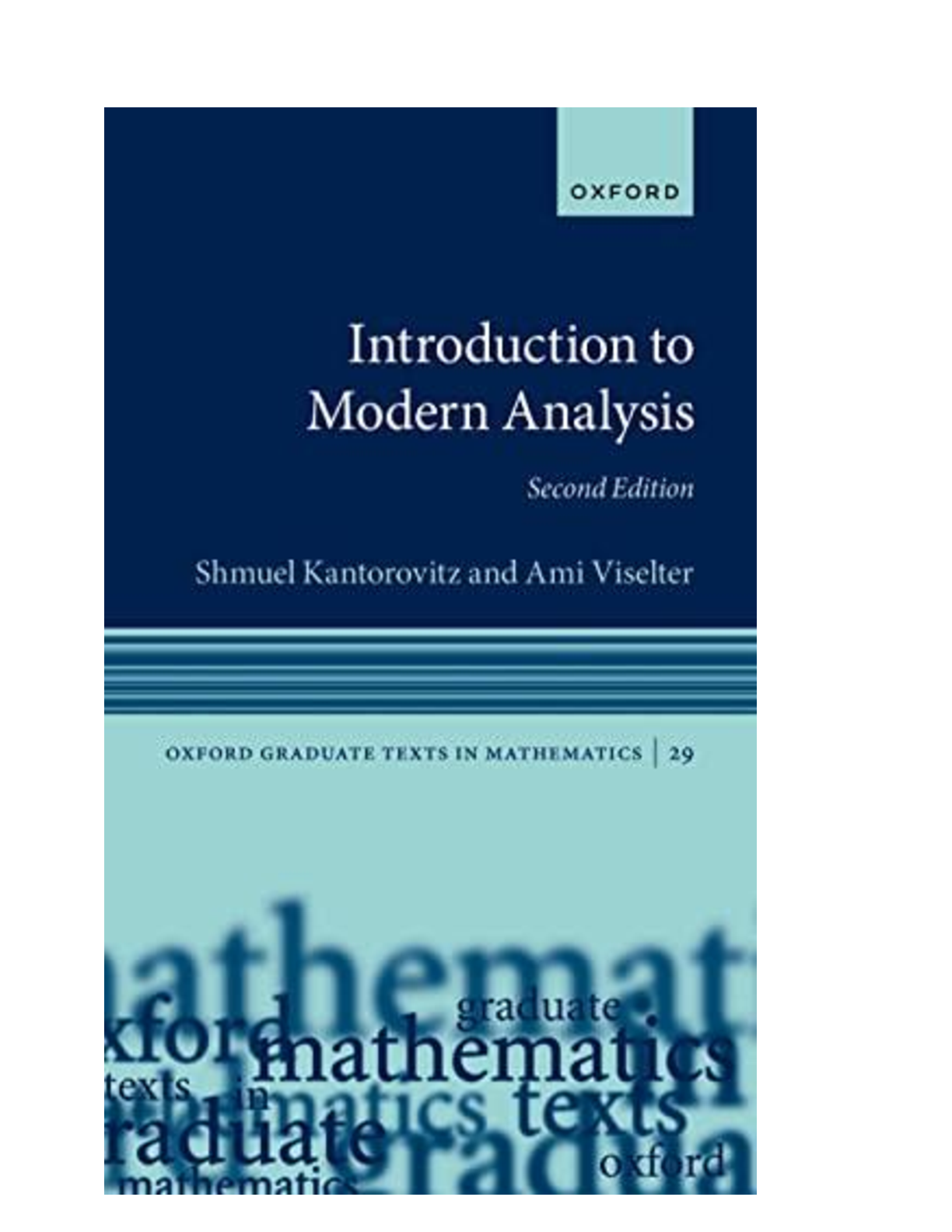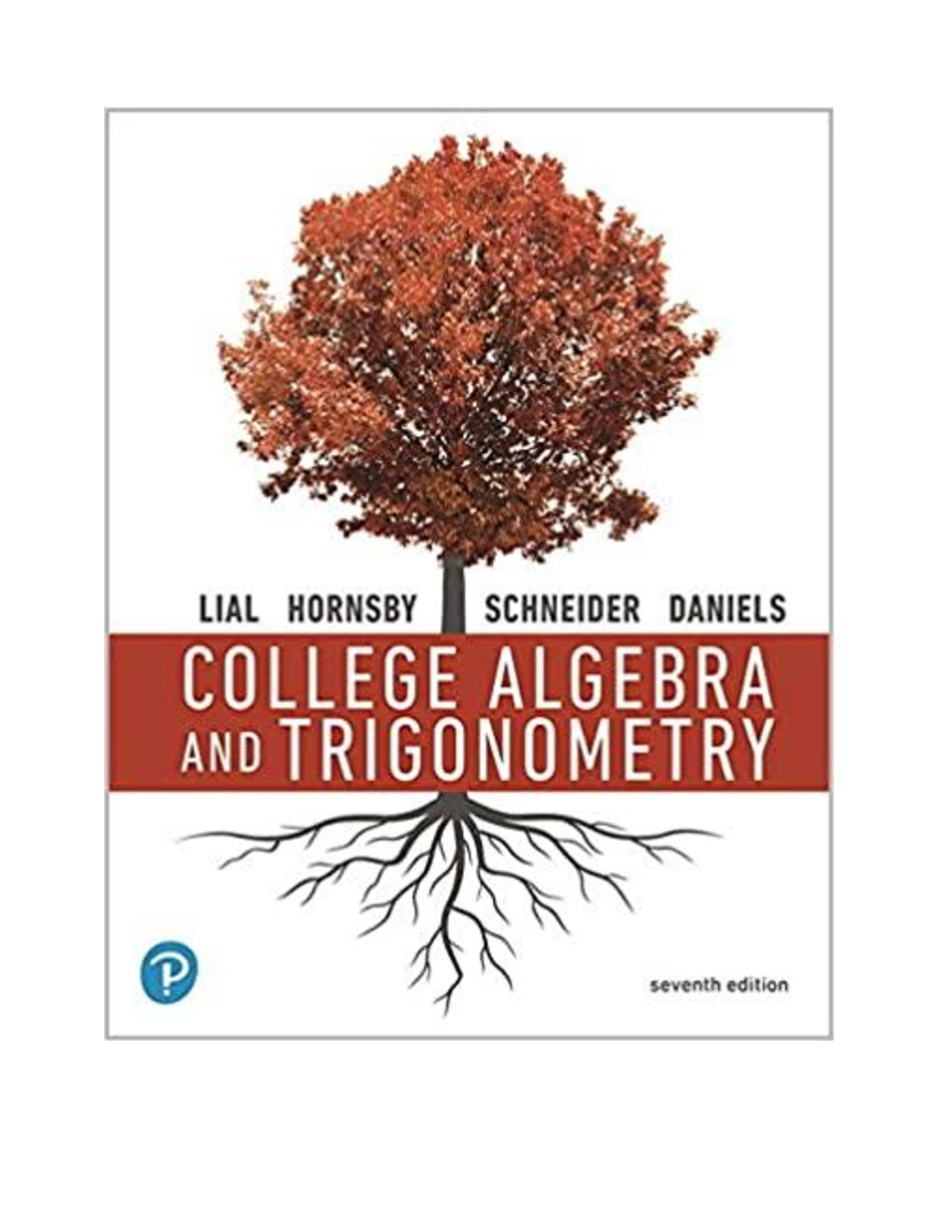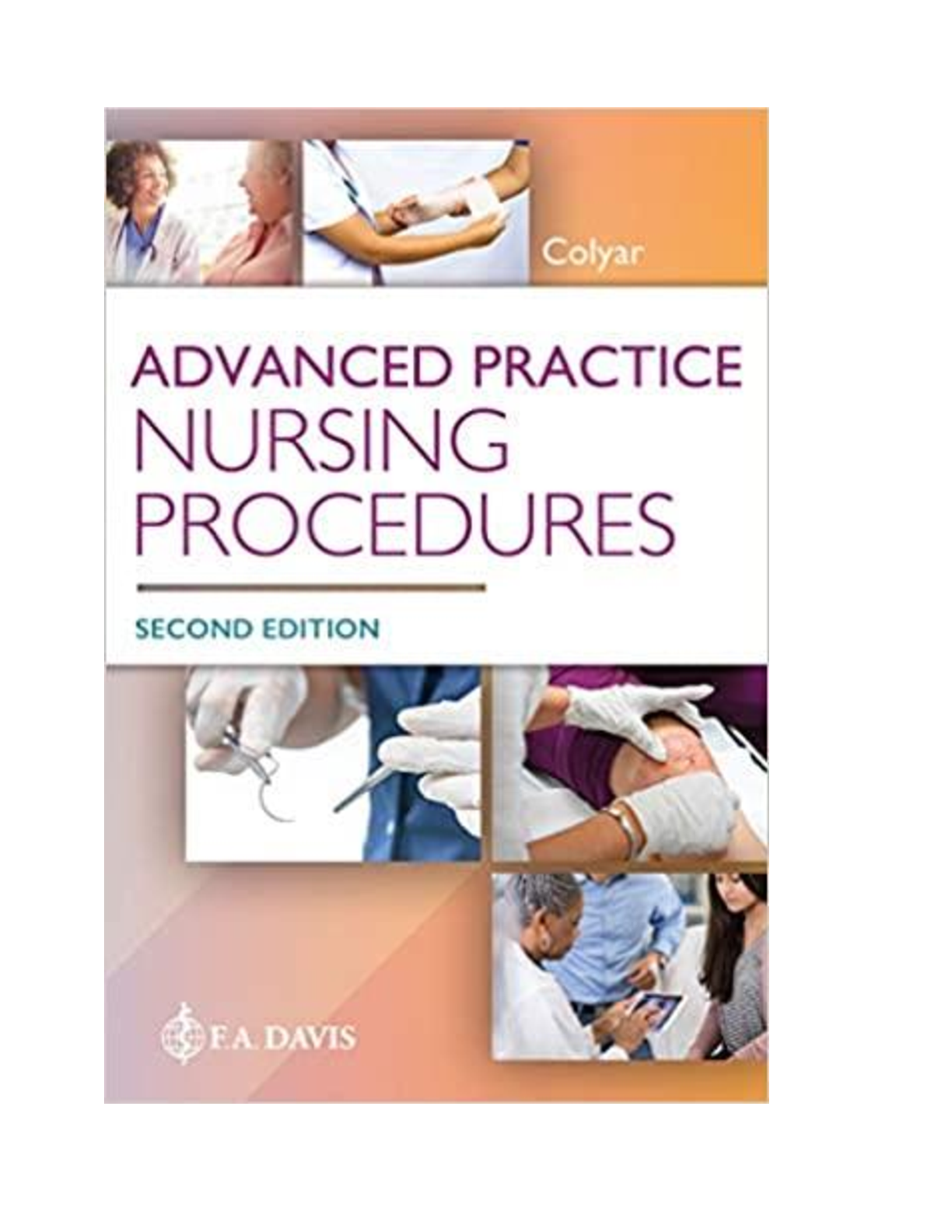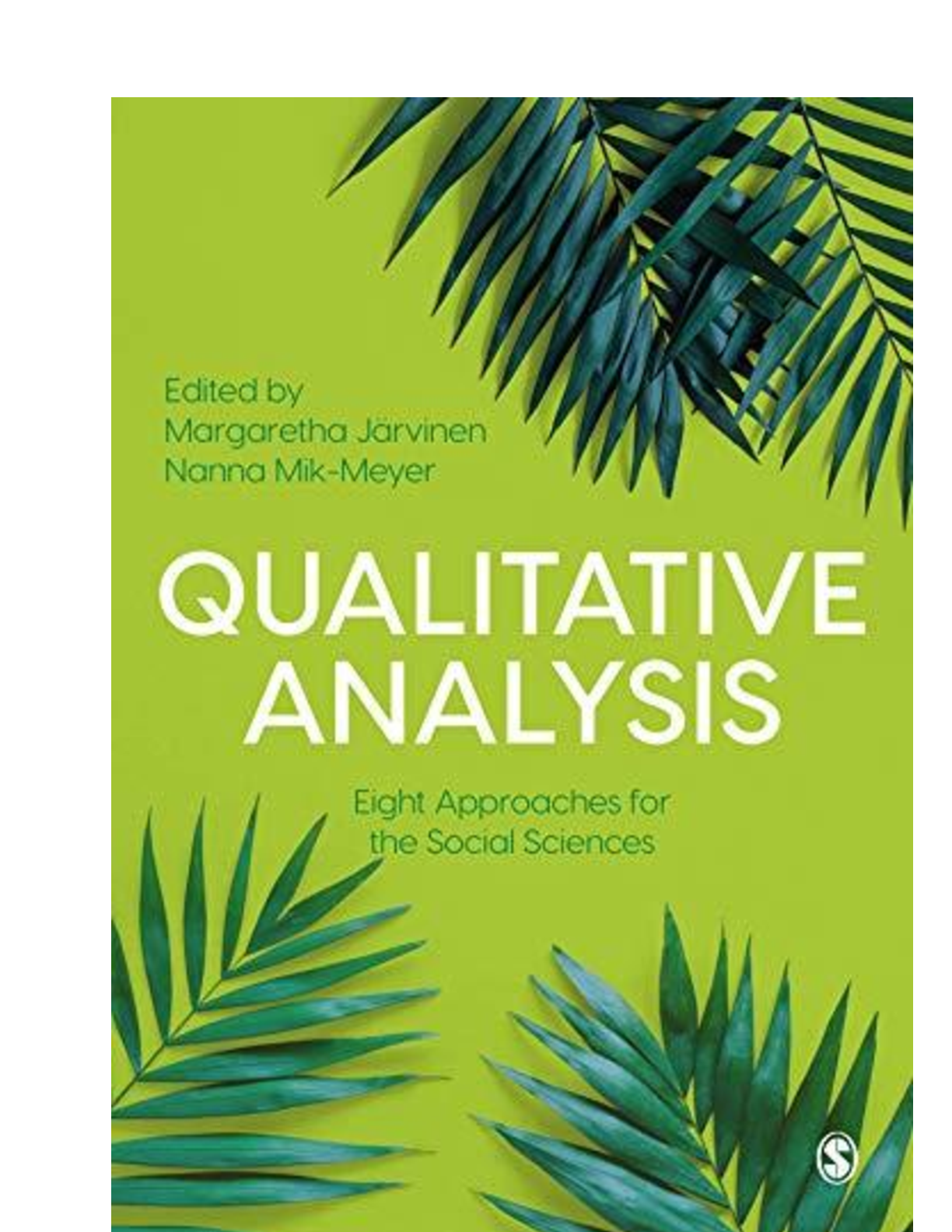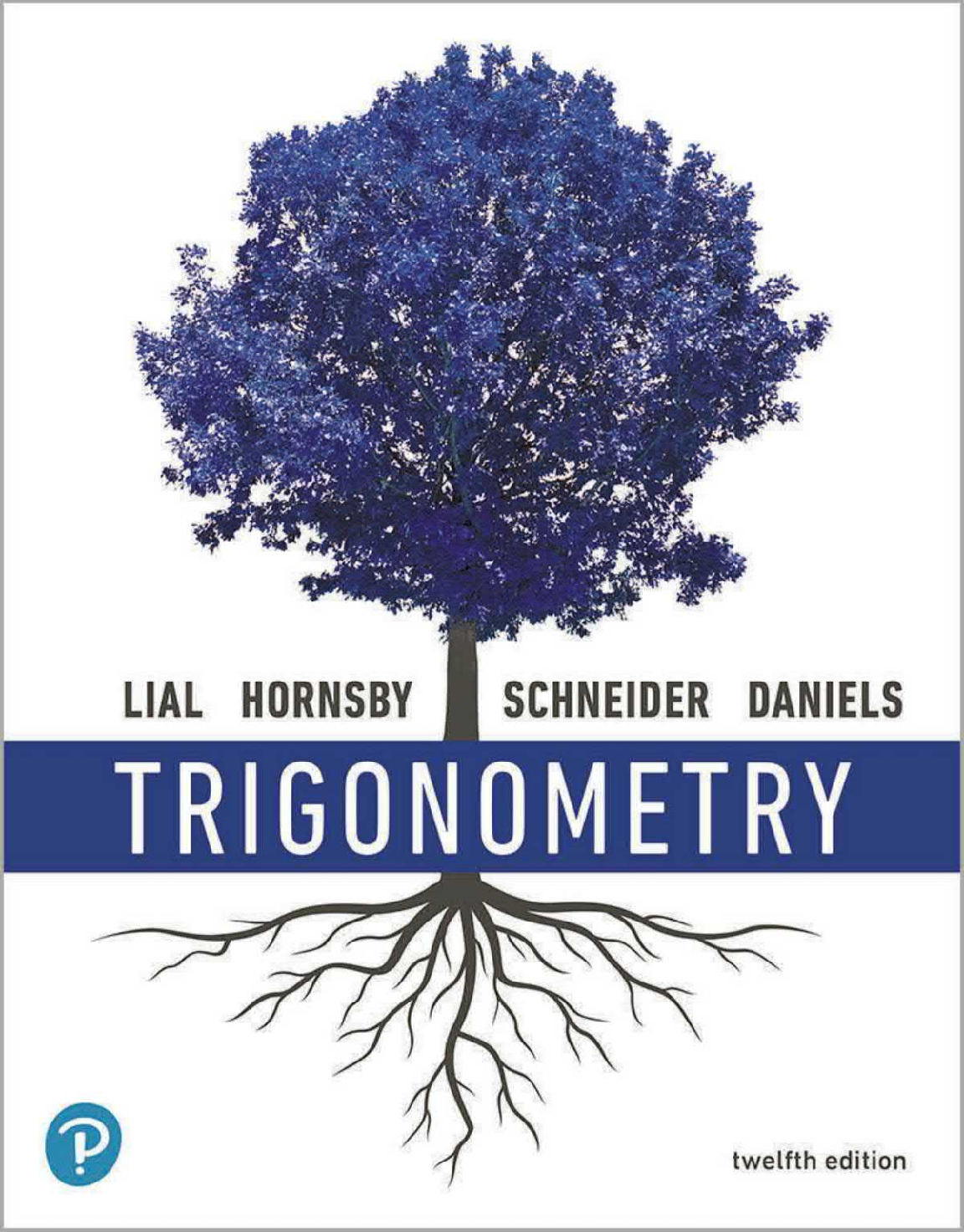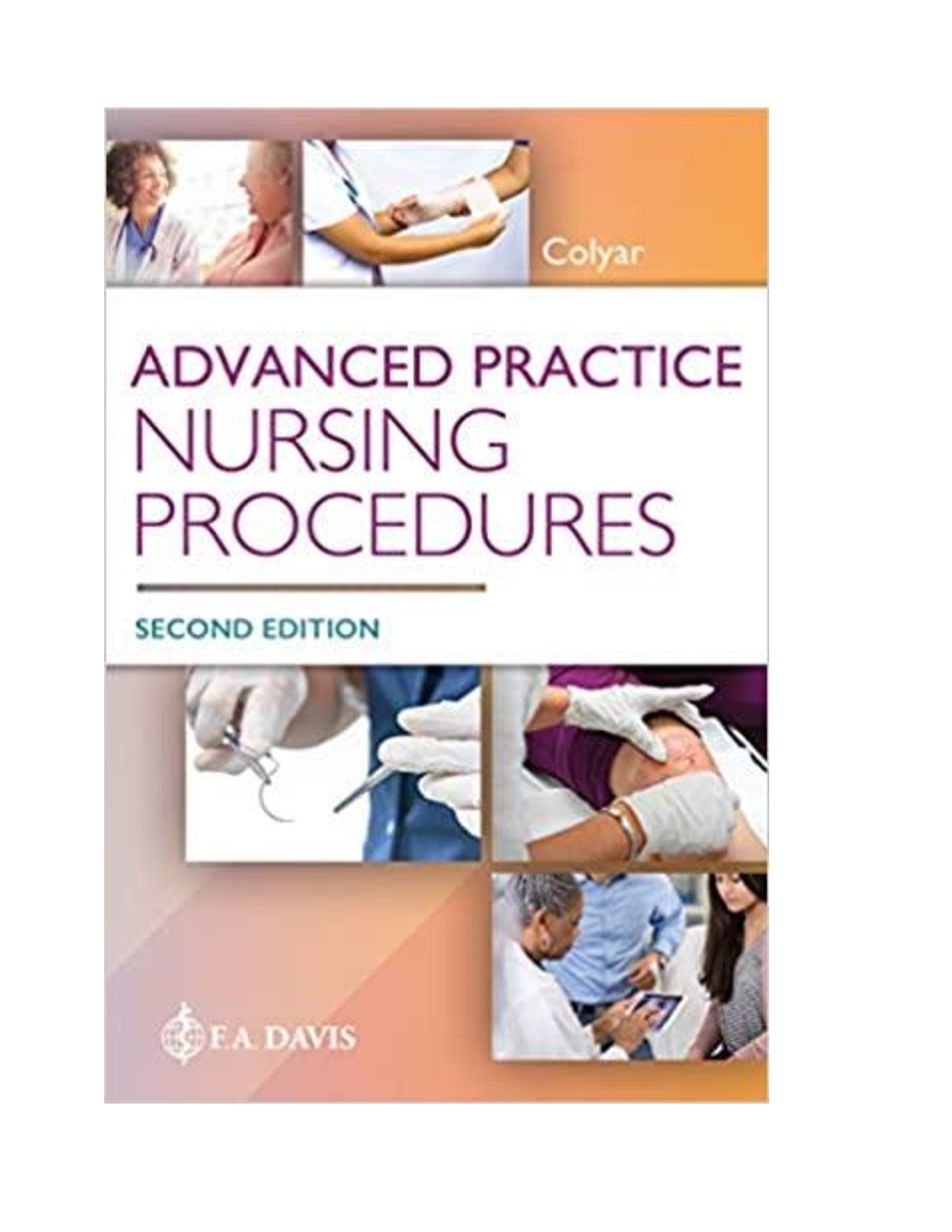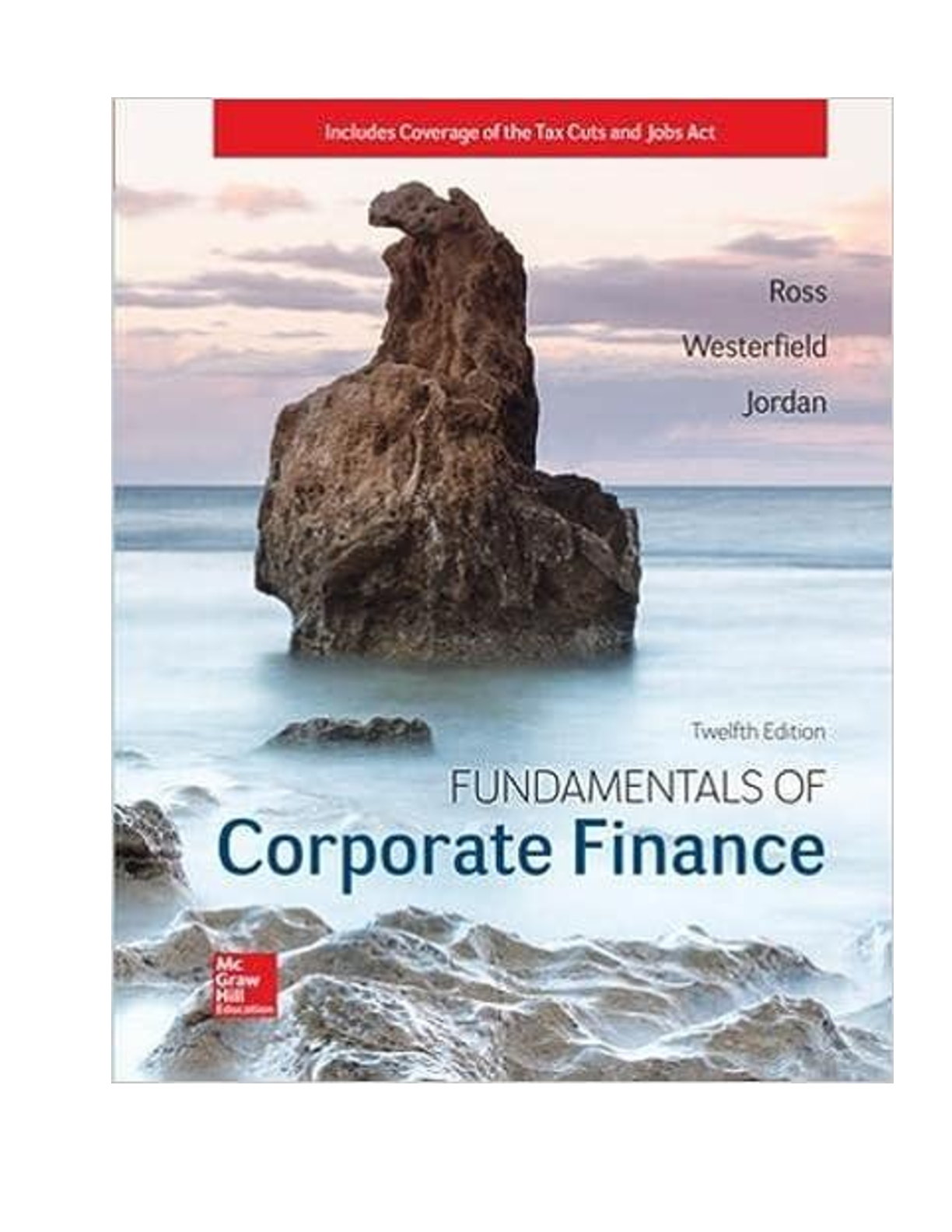Mathematics > E-Book > Beginning & Intermediate Algebra, 7th Edition By Margaret Lial, John Hornsby, Terry McGinnis (eBook (All)
Beginning & Intermediate Algebra, 7th Edition By Margaret Lial, John Hornsby, Terry McGinnis (eBook PDF)
Document Content and Description Below
Beginning and Intermediate Algebra Contents Preface Welcome to the 7th Edition What’s New in this Edition? Content Changes Lial Developmental Hallmark Features Acknowledgments Dedication Re... sources for Success Resources for Success Resources for Success Study Skills Study Skill 1 Using Your Math Text Study Skill 2 Reading Your Math Text Approaches to Reading Your Math Text Tips for Reading Your Math Text Study Skill 3 Taking Lecture Notes Study Skill 4 Completing Your Homework Homework Tips Study Skill 5 Using Study Cards Vocabulary Cards Procedure (“Steps”) Cards Practice Problem Cards Study Skill 6 Managing Your Time Time Management Tips Study Skill 7 Reviewing a Chapter Techniques for Reviewing a Chapter Study Skill 8 Taking Math Tests Study Skill 9 Analyzing Your Test Results Typical Reasons for Errors on Math Tests Study Skill 10 Preparing for Your Math Final Exam Final Exam Preparation Suggestions Chapter R Prealgebra Review Chapter Contents R.1 Fractions Objectives Objective 1 Write numbers in factored form Objective 2 Write fractions in lowest terms Objective 3 Convert between improper fractions and mixed numbers Objective 4 Multiply and divide fractions Objective 5 Add and subtract fractions Objective 6 Solve applied problems that involve fractions Objective 7 Interpret data in a circle graph R.1 Exercises R.2 Decimals and Percents Objectives Objective 1 Write decimals as fractions Objective 2 Add and subtract decimals Objective 3 Multiply and divide decimals Objective 4 Write fractions as decimals Objective 5 Write percents as decimals and decimals as percents Objective 6 Write percents as fractions and fractions as percents Objective 7 Solve applied problems that involve percents R.2 Exercises Chapter 1 The Real Number System Chapter Contents 1.1 Exponents, Order of Operations, and Inequality Objectives Objective 1 Use exponents Objective 2 Use the rules for order of operations Objective 3 Use more than one grouping symbol Objective 4 Use inequality symbols in statements Objective 5 Translate word statements to symbols Objective 6 Write statements that change the direction of inequality symbols 1.1 Exercises 1.2 Variables, Expressions, and Equations Objectives Objective 1 Evaluate algebraic expressions, given values for the variables Objective 2 Translate word phrases to algebraic expressions Objective 3 Identify solutions of equations Objective 4 Identify solutions of equations from a set of numbers Objective 5 Distinguish between expressions and equations 1.2 Exercises 1.3 Real Numbers and the Number Line Objectives Objective 1 Classify numbers and graph them on number lines Objective 2 Use inequality symbols with real numbers Objective 3 Find the additive inverse of a real number Objective 4 Find the absolute value of a real number Objective 5 Interpret meanings of real numbers from a table of data 1.3 Exercises 1.4 Adding and Subtracting Real Numbers Objectives Objective 1 Add two numbers with the same sign Objective 2 Add two numbers with different signs Objective 3 Use the definition of subtraction Objective 4 Use the rules for order of operations when adding and subtracting signed numbers Objective 5 Translate words and phrases involving addition and subtraction Objective 6 Use signed numbers to interpret data 1.4 Exercises 1.5 Multiplying and Dividing Real Numbers Objectives Objective 1 Find the product of a positive number and a negative number Objective 2 Find the product of two negative numbers Objective 3 Identify factors of integers Objective 4 Use the reciprocal of a number to apply the definition of division Objective 5 Use the rules for order of operations when multiplying and dividing signed numbers Objective 6 Evaluate algebraic expressions given values for the variables Objective 7 Translate words and phrases involving multiplication and division Objective 8 Translate simple sentences into equations 1.5 Exercises Summary Exercises: Performing Operations with Real Numbers 1.6 Properties of Real Numbers Objectives Objective 1 Use the commutative properties Objective 2 Use the associative properties Objective 3 Use the identity properties Objective 4 Use the inverse properties Objective 5 Use the distributive property 1.6 Exercises 1.7 Simplifying Expressions Objectives Objective 1 Simplify expressions Objective 2 Identify terms and numerical coefficients Objective 3 Identify like terms Objective 4 Combine like terms Objective 5 Simplify expressions from word phrases 1.7 Exercises Chapter 1 Summary Key Terms 1.1 1.2 1.3 1.4 1.5 1.6 1.7 New Symbols Test Your Word Power ANSWERS Chapter 1 Review Exercises Chapter 1 Mixed Review Exercises Chapter 1 Test Chapters R and 1 Cumulative Review Exercises Chapter 2 Linear Equations and Inequalities in One Variable Chapter Content 2.1 The Addition Property of Equality Objectives Objective 1 Identify linear equations Objective 2 Use the addition property of equality Objective 3 Simplify, and then use the addition property of equality 2.1 Exercises 2.2 The Multiplication Property of Equality Objectives Objective 1 Use the multiplication property of equality Objective 2 Simplify, and then use the multiplication property of equality 2.2 Exercises 2.3 Solving Linear Equations Using Both Properties of Equality Objectives Objective 1 Use the four steps for solving a linear equation Objective 2 Solve equations with no solution or infinitely many solutions Objective 3 Write expressions for two related unknown quantities 2.3 Exercises 2.4 Clearing Fractions and Decimals When Solving Linear Equations Objectives Objective 1 Solve equations with fractions as coefficients Objective 2 Solve equations with decimals as coefficients 2.4 Exercises Summary Exercises Applying Methods for Solving Linear Equations 2.5 Applications of Linear Equations Objectives Objective 1 Learn the six steps for solving applied problems Objective 2 Solve problems involving unknown numbers Objective 3 Solve problems involving sums of quantities Objective 4 Solve problems involving consecutive integers Objective 5 Solve problems involving complementary and supplementary angles 2.5 Exercises 2.6 Formulas and Additional Applications from Geometry Objectives Objective 1 Solve a formula for one variable, given values of the other variables Objective 2 Use a formula to solve an applied problem Objective 3 Solve problems involving vertical angles and straight angles Objective 4 Solve a formula for a specified variable 2.6 Exercises 2.7 Ratio, Proportion, and Percent Objectives Objective 1 Write ratios Objective 2 Solve proportions Objective 3 Solve applied problems using proportions Objective 4 Find percents and percentages 2.7 Exercises 2.8 Further Applications of Linear Equations Objectives Objective 1 Solve percent problems involving rates Objective 2 Solve problems involving mixtures Objective 3 Solve problems involving simple interest Objective 4 Solve problems involving denominations of money Objective 5 Solve problems involving distance, rate, and time 2.8 Exercises 2.9 Solving Linear Inequalities Objectives Objective 1 Graph intervals on a number line Objective 2 Use the addition property of inequality Objective 3 Use the multiplication property of inequality Objective 4 Solve linear inequalities using both properties of inequality Objective 5 Solve applied problems using inequalities Objective 6 Solve linear inequalities with three parts 2.9 Exercises Chapter 2 Summary Key Terms 2.1 2.3 2.5 2.6 2.7 2.9 New Symbols Test Your Word Power Answers Chapter 2 Review Exercises Chapter 2 Mixed Review Exercises Chapter 2 Test Chapters R–2 Cumulative Review Exercises Chapter 3 Linear Equations in Two Variables Chapter Contents 3.1 Linear Equations and Rectangular Coordinates Objectives Objective 1 Interpret line graphs Objective 2 Write a solution as an ordered pair Objective 3 Determine whether a given ordered pair is a solution of a given equation Objective 4 Complete ordered pairs for a given equation Objective 5 Complete a table of values Objective 6 Plot ordered pairs 3.1 Exercises 3.2 Graphing Linear Equations in Two Variables Objectives Objective 1 Graph linear equations by plotting ordered pairs Objective 2 Find intercepts Objective 3 Graph linear equations of the form Ax+Bx=0 Objective 4 Graph linear equations of the form y=b or x=a Objective 5 Use a linear equation to model data 3.2 Exercises 3.3 The Slope of a Line Objectives Objective 1 Find the slope of a line given two points Objective 2 Find the slope from the equation of a line Objective 3 Use slopes to determine whether two lines are parallel, perpendicular, or neither 3.3 Exercises 3.4 Slope-Intercept Form of a Linear Equation Objectives Objective 1 Use slope-intercept form of the equation of a line Objective 2 Graph a line using its slope and a point on the line Objective 3 Write an equation of a line using its slope and any point on the line Objective 4 Graph and write equations of horizontal and vertical lines 3.4 Exercises 3.5 Point-Slope Form of a Linear Equation and Modeling Objectives Objective 1 Use point-slope form to write an equation of a line Objective 2 Write an equation of a line using two points on the line Objective 3 Write an equation of a line that fits a data set 3.5 Exercises Summary Exercises: Applying Graphing and Equation-Writing Techniques for Lines Chapter 3 Summary Key Terms 3.1 3.2 3.3 New Symbols Test Your Word Power Answers Chapter 3 Review Exercises Chapter 3 Mixed Review Exercises Chapter 3 Test Chapters R–3 Cumulative Review Exercises Chapter 4 Exponents and Polynomials Chapter Contents 4.1 The Product Rule and Power Rules for Exponents Objectives Objective 1 Use exponents Objective 2 Use the product rule for exponents Objective 3 Use the rule (am)n=amn. Objective 4 Use the rule (ab)m=ambm Objective 5 Use the rule (ab)m=ambm. Objective 6 Use combinations of the rules for exponents Objective 7 Apply the rules for exponents in a geometry application 4.1 Exercises 4.2 Integer Exponents and the Quotient Rule Objectives Objective 1 Use 0 as an exponent Objective 2 Use negative numbers as exponents Objective 3 Use the quotient rule for exponents Objective 4 Use combinations of the rules for exponents 4.2 Exercises Summary Exercises: Applying the Rules for Exponents 4.3 Scientific Notation Objectives Objective 1 Express numbers in scientific notation Objective 2 Convert numbers in scientific notation to standard notation Objective 3 Use scientific notation in calculations 4.3 Exercises 4.4 Adding, Subtracting, and Graphing Polynomials Objectives Objective 1 Identify terms and coefficients Objective 2 Combine like terms Objective 3 Describe polynomials using appropriate vocabulary Objective 4 Evaluate polynomials Objective 5 Add and subtract polynomials Objective 6 Graph equations defined by polynomials of degree 2 4.4 Exercises 4.5 Multiplying Polynomials Objectives Objective 1 Multiply monomials Objective 2 Multiply a monomial and a polynomial Objective 3 Multiply two polynomials Objective 4 Multiply binomials using the FOIL method 4.5 Exercises 4.6 Special Products Objectives Objective 1 Square binomials Objective 2 Find the product of the sum and difference of two terms Objective 3 Find greater powers of binomials 4.6 Exercises 4.7 Dividing Polynomials Objectives Objective 1 Divide a polynomial by a monomial Objective 2 Divide a polynomial by a polynomial Objective 3 Apply polynomial division in a geometry problem 4.7 Exercises Chapter 4 Summary Key Terms 4.1 4.3 4.4 4.5 4.6 New Symbols Test Your Word Power Answers Chapter 4 Review Exercises Chapter 4 Mixed Review Exercises Chapter 4 Test Chapters R–4 Cumulative Review Exercises Chapter 5 Factoring and Applications Chapter Contents 5.1 Greatest Common Factors; Factoring by Grouping Objectives Objective 1 Find the greatest common factor of a list of numbers Objective 2 Find the greatest common factor of a list of variable terms Objective 3 Factor out the greatest common factor Objective 4 Factor by grouping 5.1 Exercises 5.2 Factoring Trinomials Objectives Objective 1 Factor trinomials with coefficient 1 for the second-degree term Objective 2 Factor out the greatest common factor first 5.2 Exercises 5.3 More on Factoring Trinomials Objectives Objective 1 Factor trinomials by grouping when the coefficient of the second- degree term is not 1 Objective 2 Factor trinomials using the FOIL method 5.3 Exercises 5.4 Special Factoring Techniques Objectives Objective 1 Factor a difference of squares Objective 2 Factor a perfect square trinomial Objective 3 Factor a difference of cubes Objective 4 Factor a sum of cubes 5.4 Exercises Summary Exercises: Recognizing and Applying Factoring Strategies 5.5 Solving Quadratic Equations Using the Zero-Factor Property Objectives Objective 1 Solve quadratic equations using the zero-factor property Objective 2 Solve other equations using the zero-factor property 5.5 Exercises 5.6 Applications of Quadratic Equations Objectives Objective 1 Solve problems involving geometric figures Objective 2 Solve problems involving consecutive integers Objective 3 Solve problems by applying the Pythagorean theorem Objective 4 Solve problems using given quadratic models 5.6 Exercises Chapter 5 Summary Key Terms 5.1 5.2 5.4 5.5 5.6 Test Your Word Power Answers Chapter 5 Review Exercises Chapter 5 Mixed Review Exercises Chapter 5 Test Chapters R–5 Cumulative Review Exercises Chapter 6 Rational Expressions and Applications Chapter Contents 6.1 The Fundamental Property of Rational Expressions Objectives Objective 1 Find the numerical value of a rational expression Objective 2 Find the values of the variable for which a rational expression is undefined Objective 3 Write rational expressions in lowest terms Objective 4 Recognize equivalent forms of rational expressions 6.1 Exercises 6.2 Multiplying and Dividing Rational Expressions Objectives Objective 1 Multiply rational expressions Objective 2 Find reciprocals of rational expressions Objective 3 Divide rational expressions 6.2 Exercises 6.3 Least Common Denominators Objectives Objective 1 Find the least common denominator for a list of fractions Objective 2 Write equivalent rational expressions 6.3 Exercises 6.4 Adding and Subtracting Rational Expressions Objectives Objective 1 Add rational expressions having the same denominator Objective 2 Add rational expressions having different denominators Objective 3 Subtract rational expressions 6.4 Exercises 6.5 Complex Fractions Objectives Objective 1 Define and recognize a complex fraction Objective 2 Simplify a complex fraction by writing it as a division problem (Method 1) Objective 3 Simplify a complex fraction by multiplying numerator and denominator by the LCD (Method 2) Objective 4 Simplify rational expressions with negative exponents 6.5 Exercises 6.6 Solving Equations with Rational Expressions Objectives Objective 1 Distinguish between operations with rational expressions and equations with terms that are rational expressions Objective 2 Solve equations with rational expressions Objective 3 Solve a formula for a specified variable 6.6 Exercises Summary Exercises: Simplifying Rational Expressions vs. Solving Rational Equations 6.7 Applications of Rational Expressions Objectives Objective 1 Solve problems about numbers Objective 2 Solve problems about distance, rate, and time Objective 3 Solve problems about work 6.7 Exercises Chapter 6 Summary Key Terms 6.1 6.2 6.3 6.5 6.6 Test Your Word Power Answers Chapter 6 Review Exercises Chapter 6 Mixed Review Exercises Chapter 6 Test Chapters R–6 Cumulative Review Exercises Chapter 7 Linear Equations, Graphs, and Systems Chapter Contents 7.1 Review of Graphs and Slopes of Lines Objectives Objective 1 Plot ordered pairs Objective 2 Graph lines and find intercepts Objective 3 Graph equations of horizontal and vertical lines Objective 4 Find the midpoint of a line segment Objective 5 Find the slope of a line Objective 6 Graph a line given its slope and a point on the line Objective 7 Determine whether two lines are parallel, perpendicular, or neither using slope Objective 8 Solve problems involving average rate of change 7.1 Exercises 7.2 Review of Equations of Lines; Linear Models Objectives Objective 1 Write an equation of a line given its slope and y-intercept Objective 2 Graph a line using its slope and y-intercept Objective 3 Write an equation of a line given its slope and a point on the line Objective 4 Write an equation of a line given two points on the line Objective 5 Write equations of horizontal and vertical lines Objective 6 Write an equation of a line parallel or perpendicular to a given line Objective 7 Write an equation of a line that models real data 7.2 Exercises 7.3 Solving Systems of Linear Equations by Graphing Objectives Objective 1 Determine whether a given ordered pair is a solution of a system Objective 2 Solve linear systems by graphing Objective 3 Solve special systems by graphing Objective 4 Identify special systems without graphing 7.3 Exercises 7.4 Solving Systems of Linear Equations by Substitution Objectives Objective 1 Solve linear systems by substitution Objective 2 Solve special systems by substitution Objective 3 Solve linear systems with fractions and decimals 7.4 Exercises 7.5 Solving Systems of Linear Equations by Elimination Objectives Objective 1 Solve linear systems by elimination Objective 2 Multiply when using the elimination method Objective 3 Use an alternative method to find the second value in a solution Objective 4 Solve special systems by elimination 7.5 Exercises Summary Exercises: Applying Techniques for Solving Systems of Linear Equations 7.6 Systems of Linear Equations in Three Variables Objectives Objective 1 Understand the geometry of systems of three equations in three variables Objective 2 Solve linear systems (with three equations and three variables) by elimination Objective 3 Solve linear systems (with three equations and three variables) in which some of the equations have missing terms Objective 4 Solve special systems 7.6 Exercises 7.7 Applications of Systems of Linear Equations Objectives Objective 1 Solve geometry problems using two variables Objective 2 Solve money problems using two variables Objective 3 Solve mixture problems using two variables Objective 4 Solve distance-rate-time problems using two variables Objective 5 Solve problems with three variables using a system of three equations 7.7 Exercises Chapter 7 Summary Key Terms 7.1 7.3 7.6 New Symbols Test Your Word Power Answers Chapter7 Review Exercises Chapter 7 Mixed Review Exercises Chapter 7 Test Chapters R–7 Cumulative Review Exercises Chapter 8 Inequalities and Absolute Value Chapter Contents 8.1 Review of Linear Inequalities in One Variable Objectives Objective 1 Review inequalities and interval notation Objective 2 Solve linear inequalities using the addition property Objective 3 Solve linear inequalities using the multiplication property Objective 4 Solve linear inequalities with three parts 8.1 Exercises 8.2 Set Operations and Compound Inequalities Objectives Objective 1 Recognize set intersection and union Objective 2 Find the intersection of two sets Objective 3 Solve compound inequalities with the word and Objective 4 Find the union of two sets Objective 5 Solve compound inequalities with the word or 8.2 Exercises 8.3 Absolute Value Equations and Inequalities Objectives Objective 1 Use the distance definition of absolute value Objective 2 Solve equations of the form |ax+b|=k, for k>0. Objective 3 Solve inequalities of the form |ax+b|<k and of the form |ax+b|>k for k>0. Objective 4 Solve absolute value equations that involve rewriting Objective 5 Solve equations of the form |ax+b|=|cx+d|. Objective 6 Solve special cases of absolute value equations and inequalities Objective 7 Solve an application involving relative error 8.3 Exercises Summary Exercises: Solving Linear and Absolute Value Equations and Inequalities 8.4 Linear Inequalities and Systems in Two Variables Objectives Objective 1 Graph linear inequalities in two variables 8.4 Exercises Chapter 8 Summary Key Terms 8.1 8.2 8.3 8.4 New Symbols Test Your Word Power ANSWERS Chapter 8 Review Exercises Chapter 8 Mixed Review Exercises Chapter 8 Test Chapters R–8 Cumulative Review Exercises Chapter 9 Relations and Functions Chapter Contents 9.1 Introduction to Relations and Functions Objectives Objective 1 Define and identify relations and functions Objective 2 Find the domain and range Objective 3 Identify functions defined by graphs and equations 9.1 Exercises 9.2 Function Notation and Linear Functions Objectives Objective 1 Use function notation Objective 2 Graph linear and constant functions 9.2 Exercises 9.3 Polynomial Functions, Graphs, Operations, and Composition Objectives Objective 1 Recognize and evaluate polynomial functions Objective 2 Graph basic polynomial functions Objective 3 Perform operations on polynomial functions Objective 4 Find the composition of functions 9.3 Exercises 9.4 Variation Objectives Objective 1 Write an equation expressing direct variation Objective 2 Find the constant of variation, and solve direct variation problems Objective 3 Solve inverse variation problems Objective 4 Solve joint variation problems Objective 5 Solve combined variation problems 9.4 Exercises Chapter 9 Summary Key Terms 9.1 9.2 9.3 9.4 New Symbols Test Your Word Power ANSWERS Chapter 9 Review Exercises Chapter 9 Mixed Review Exercises Chapter 9 Test Chapters R–9 Cumulative Review Exercises Chapter 10 Roots, Radicals, and Root Functions Chapter Contents 10.1 Radical Expressions and Graphs Objectives Objective 1 Find square roots Objective 2 Determine whether a given root is rational, irrational, or not a real number Objective 3 Find cube, fourth, and other roots Objective 4 Graph functions defined by radical expressions Objective 5 Find nth roots of nth powers Objective 6 Use a calculator to find roots 10.1 Exercises 10.2 Rational Exponents Objectives Objective 1 Use exponential notation for nth roots Objective 2 Define and use expressions of the form am/n Objective 3 Convert between radicals and rational exponents Objective 4 Use the rules for exponents with rational exponents 10.2 Exercises 10.3 Simplifying Radicals, the Distance Formula, and Circles Objectives Objective 1 Use the product rule for radicals Objective 2 Use the quotient rule for radicals Objective 3 Simplify radicals Objective 4 Simplify products and quotients of radicals with different indexes Objective 5 Use the Pythagorean theorem Objective 6 Use the distance formula Objective 7 Find an equation of a circle given its center and radius 10.3 Exercises 10.4 Adding and Subtracting Radical Expressions Objective Objective 1 Simplify radical expressions involving addition and subtraction 10.4 Exercises 10.5 Multiplying and Dividing Radical Expressions Objectives Objective 1 Multiply radical expressions Objective 2 Rationalize denominators with one radical term Objective 3 Rationalize denominators with binomials involving radicals Objective 4 Write radical quotients in lowest terms 10.5 Exercises Summary Exercises Performing Operations with Radicals and Rational Exponents 10.6 Solving Equations with Radicals Objectives Objective 1 Solve radical equations using the power rule Objective 2 Solve radical equations that require additional steps Objective 3 Solve radical equations with indexes greater than 2 Objective 4 Use the power rule to solve a formula for a specified variable 10.6 Exercises 10.7 Complex Numbers Objectives Objective 1 Simplify numbers of the form −b, where b>0 Objective 2 Identify subsets of the complex numbers Objective 3 Add and subtract complex numbers Objective 4 Multiply complex numbers Objective 5 Divide complex numbers Objective 6 Simplify powers of i 10.7 Exercises Chapter 10 Summary Key Terms 10.1 10.3 10.5 10.6 10.7 New Symbols Test Your Word Power Answers Chapter 10 Review Exercises Chapter 10 Mixed Review Exercises Chapter 10 Test Chapters R–10 Cumulative Review Exercises Chapter 11 Quadratic Equations, Inequalities, and Functions Chapter Contents 11.1 Solving Quadratic Equations by the Square Root Property Objectives Objective 1 Solve quadratic equations using the zero-factor property. (Review) Objective 2 Solve equations of the form x2=k, where k>0 Objective 3 Solve equations of the form (ax+b)2=k, where k>0 Objective 4 Solve quadratic equations with solutions that are not real numbers 11.1 Exercises 11.2 Solving Quadratic Equations by Completing the Square Objectives Objectives 1 Solve quadratic equations by completing the square when the coefficient of the second-degree term is 1 Objective 2 Solve quadratic equations by completing the square when the coefficient of the second-degree term is not 1 Objective 3 Simplify the terms of an equation before solving 11.2 Exercises 11.3 Solving Quadratic Equations by the Quadratic Formula Objectives Objective 1 Derive the quadratic formula Objective 2 Solve quadratic equations using the quadratic formula Objective 3 Use the discriminant to determine number and type of solutions 11.3 Exercises 11.4 Equations That Lead to Quadratic Methods Objectives Objective 1 Solve rational equations that lead to quadratic equations Objective 2 Solve applied problems involving quadratic equations Objective 3 Solve radical equations that lead to quadratic equations Objective 4 Solve equations that are quadratic in form 11.4 Exercises SUMMARY EXERCISES Applying Methods for Solving Quadratic Equations 11.5 Formulas and Further Applications Objectives Objective 1 Solve formulas involving squares and square roots for specified variables Objective 2 Solve applied problems using the Pythagorean theorem Objective 3 Solve applied problems using area formulas Objective 4 Solve applied problems using quadratic functions as models 11.5 Exercises 11.6 Graphs of Quadratic Functions Objectives Objective 1 Graph a quadratic function Objective 2 Graph parabolas with horizontal and vertical shifts Objective 3 Use the coefficient of x2 to predict the shape and direction in which a parabola opens Objective 4 Find a quadratic function to model data 11.6 Exercises 11.7 More about Parabolas and Their Applications Objectives Objective 1 Find the vertex of a vertical parabola Objective 2 Graph a quadratic function Objective 3 Use the discriminant to find the number of x-intercepts of a parabola with a vertical axis Objective 4 Use quadratic functions to solve problems involving maximum or minimum value Objective 5 Graph parabolas with horizontal axes 11.7 Exercises 11.8 Polynomial and Rational Inequalities Objectives Objective 1 Solve quadratic inequalities Objective 2 Solve polynomial inequalities of degree 3 or greater Objective 3 Solve rational inequalities 11.8 Exercises Chapter 11 Summary Key Terms 11.1 11.3 11.4 11.6 11.8 Test Your Word Power Answers Chapter 11 Review Exercises Chapter 11 Mixed Review Exercises Chapter 11 Test Chapters R-11 Cumulative Review Exercises Chapter 12 Inverse, Exponential, and Logarithmic Functions Chapter Contents 12.1 Inverse Functions Objectives Objective 1 Decide whether a function is one-to-one and, if it is, find its inverse Objective 2 Use the horizontal line test to determine whether a function is one-to-one Objective 3 Find the equation of the inverse of a function Objective 4 Graph f−1, given the graph of f 12.1 Exercises 12.2 Exponential Functions Objectives Objective 1 Evaluate exponential expressions using a calculator Objective 2 Define and graph exponential functions Objective 3 Solve exponential equations of the form ax=ak for x Objective 4 Use exponential functions in applications involving growth or decay 12.2 Exercises 12.3 Logarithmic Functions Objectives Objective 1 Define a logarithm Objective 2 Convert between exponential and logarithmic forms, and evaluate logarithms Objective 3 Solve logarithmic equations of the form loga b=k for a, b, or k Objective 4 Use the definition of logarithm to simplify logarithmic expressions Objective 5 Define and graph logarithmic functions Objective 6 Use logarithmic functions in applications involving growth or decay 12.3 Exercises 12.4 Properties of Logarithms Objectives Objective 1 Use the product rule for logarithms Objective 2 Use the quotient rule for logarithms Objective 3 Use the power rule for logarithms Objective 4 Use properties to write alternative forms of logarithmic expressions 12.4 Exercises 12.5 Common and Natural Logarithms Objectives Objective 1 Evaluate common logarithms using a calculator Objective 2 Use common logarithms in applications Objective 3 Evaluate natural logarithms using a calculator Objective 4 Use natural logarithms in applications Objective 5 Use the change-of-base rule 12.5 Exercises 12.6 Exponential and Logarithmic Equations; Further Applications Objectives Objective 1 Solve equations involving variables in the exponents Objective 2 Solve equations involving logarithms Objective 3 Solve applications of compound interest Objective 4 Solve applications involving base e exponential growth and decay 12.6 Exercises Chapter 12 Summary Key Terms 12.1 12.2 12.3 12.5 12.6 New Symbols Test Your Word Power Answers Chapter 12 Review Exercises Chapter 12 Mixed Review Exercises Chapter 12 Test Chapters R–12 Cumulative Review Exercises Chapter 13 Nonlinear Functions, Conic Sections, and Nonlinear Systems Chapter Content 13.1 Additional Graphs of Functions Objectives Objective 1 Recognize graphs of the absolute value, reciprocal, and square root functions, and graph their translations Objective 2 Recognize and graph step functions 13.1 Exercises 13.2 Circles Revisited and Ellipses Objectives Objective 1 Graph circles Objective 2 Write an equation of a circle given its center and radius Objective 3 Determine the center and radius of a circle given its equation Objective 4 Recognize the equation of an ellipse Objective 5 Graph ellipses 13.2 Exercises 13.3 Hyperbolas and Functions Defined by Radicals Objectives Objective 1 Recognize the equation of a hyperbola Objective 2 Graph hyperbolas using asymptotes Objective 3 Identify conic sections using their equations Objective 4 Graph generalized square root functions 13.3 Exercises 13.4 Nonlinear Systems of Equations Objectives Objective 1 Solve a nonlinear system using substitution Objective 2 Solve a nonlinear system with two second- degree equations using elimination Objective 3 Solve a nonlinear system that requires a combination of methods 13.4 Exercises 13.5 Second-Degree Inequalities and Systems of Inequalities Objectives Objective 1 Graph second-degree inequalities Objective 2 Graph the solution set of a system of inequalities 13.5 Exercises Chapter 13 Summary Key Terms 13.1 13.2 13.3 13.4 13.5 New Symbols Test Your Word Power ANSWERS Chapter 13 Review Exercises Chapter 13 Mixed Review Exercises Chapter 13 Test Chapters R–13 Cumulative Review Exercises Chapter 14 Further Topics in Algebra Chapter Contents 14.1 Sequences and Series Objectives Objective 1 Define infinite and finite sequences Objective 2 Find the terms of a sequence, given the general term Objective 3 Find the general term of a sequence Objective 4 Use sequences to solve applied problems Objective 5 Use summation notation to evaluate a series Objective 6 Write a series using summation notation Objective 7 Find the arithmetic mean (average) of a group of numbers 14.1 Exercises 14.2 Arithmetic Sequences Objectives Objective 1 Find the common difference of an arithmetic sequence Objective 2 Find the general term of an arithmetic sequence Objective 3 Use an arithmetic sequence in an application Objective 4 Find any specified term or the number of terms of an arithmetic sequence Objective 5 Find the sum of a specified number of terms of an arithmetic sequence 14.2 Exercises 14.3 Geometric Sequences Objectives Objective 1 Find the common ratio of a geometric sequence Objective 2 Find the general term of a geometric sequence Objective 3 Find any specified term of a geometric sequence Objective 4 Find the sum of a specified number of terms of a geometric sequence Objective 5 Apply the formula for the future value of an ordinary annuity Objective 6 Find the sum of an infinite number of terms of a geometric sequence 14.3 Exercises 14.4 The Binomial Theorem Objectives Objective 1 Expand a binomial raised to a power Objective 2 Find any specified term of the expansion of a binomial 14.4 Exercises Chapter 14 Summary Key Terms 14.1 14.2 14.3 14.4 New Symbols Test Your Word Power Answers Chapter 14 Review Exercises Chapter 14 Mixed Review Exercises Chapter 14 Test Chapters R–14 Cumulative Review Exercises Appendix A Review of Exponents, Polynomials, and Factoring (Transition from Beginning to Intermediate Algebra) Objectives Objective 1 Review the basic rules for exponents Objective 2 Review operations with polynomials Objective 3 Review factoring techniques A Exercises Appendix B Synthetic Division Objectives Objective 1 Use synthetic division to divide by a polynomial of the form x−k Objective 2 Use the remainder theorem to evaluate a polynomial Objective 3 Use the remainder theorem to decide whether a given number is a solution of an equation B Exercises Relating Concepts: For Individual or Group Work (Exercises 41–46) Answers to Selected Exercises R Prealgebra Review Section R.1 Section R.2 1 The Real Number System Section 1.1 Section 1.2 Section 1.3 Section 1.4 Section 1.5 Summary Exercises: Performing Operations with Real Numbers Section 1.6 Section 1.7 Chapter 1 Review Exercises Chapter 1 Mixed Review Exercises Chapter 1 Test Chapters R and 1 Cumulative Review Exercises 2 Linear Equations and Inequalities in One Variable Section 2.1 Section 2.2 Section 2.3 Section 2.4 Summary Exercises: Applying Methods for Solving Linear Equations Section 2.5 Section 2.6 Section 2.7 Section 2.8 Section 2.9 Chapter 2 Review Exercises Chapter 2 Mixed Review Exercises Chapter2 Test Chapters R-2 Cumulative Review Exercises 3 Linear Equations in Two Variables Section 3.1 Section 3.2 Section 3.3 Section 3.4 Section 3.5 Summary Exercises: Applying Graphing and Equation-Writing Techniques for Lines Chapter 3 Review Exercises Chapter 3 Mixed Review Exercises Chapter 3 Test Chapters R-3 Cumulative Review Exercises 4 Exponents and Polynomials Section 4.1 Section 4.2 Summary Exercises: Applying the Rules for Exponents Section 4.3 Section 4.4 Section 4.5 Section 4.6 Section 4.7 Chapter 4 Review Exercises Chapter 4 Mixed Review Exercises Chapter 4 Test Chapters R-4 Cumulative Review Exercises 5 Factoring and Applications Section 5.1 Section 5.2 Section 5.3 Section 5.4 Summary Exercises: Recognizing and Applying Factoring Strategies Section 5.5 Section 5.6 Chapter 5 Review Exercises Chapter 5 Mixed Review Exercises Chapter 5 Test Chapters R-5 Cumulative Review Exercises 6 Rational Expressions and Applications Section 6.1 Section 6.2 Section 6.3 Section 6.4 Section 6.5 Section 6.6 Summary Exercises: Simplifying Rational Expressions vs. Solving Rational Equations Section 6.7 Chapter 6 Review Exercises Chapter 6 Mixed Review Exercises Chapter 6 Test Chapters R-6 Cumulative Review Exercises 7 Linear Equations, Graphs, and Systems Section 7.1 Section 7.2 Section 7.3 Section 7.4 Section 7.5 Summary Exercises: Applying Techniques for Solving Systems of Linear Equations Section 7.6 Section 7.7 Chapter 7 Review Exercises Chapter 7 Mixed Review Exercises Chapter 7 Test Chapters R-7 Cumulative Review Exercises 8 Inequalities and Absolute Value Section 8.1 Section 8.2 Section 8.3 Summary Exercises: Solving Linear and Absolute Value Equations and Inequalities Section 8.4 Chapter 8 Review Exercises Chapter 8 Mixed Review Exercises Chapter 8 Test Chapters R-8 Cumulative Review Exercises 9 Relations and Functions Section 9.1 Section 9.2 Section 9.3 Section 9.4 Chapter 9 Review Exercises Chapter 9 Mixed Review Exercises Chapter 9 Test Chapters R-9 Cumulative Review Exercises 10 Roots, Radicals, and Root Functions Section 10.1 Section 10.2 Section 10.3 Section 10.4 Section 10.5 Summary Exercises: Performing Operations with Radicals and Rational Exponents Section 10.6 Section 10.7 Chapter 10 Review Exercises Chapter 10 Mixed Review Exercises Chapter 10 Test Chapters R-10 Cumulative Review Exercises 11 Quadratic Equations, Inequalities, and Functions Section 11.1 Section 11.2 Section 11.3 Section 11.4 Summary Exercises: Applying Methods for Solving Quadratic Equations Section 11.5 Section 11.6 Section 11.7 Section 11.8 Chapter 11 Review Exercises Chapter 11 Mixed Review Exercises Chapter 11 Test Chapters R-11 Cumulative Review Exercises 12 Inverse, Exponential, and Logarithmic Functions Section 12.1 Section 12.2 Section 12.3 Section 12.4 Section 12.5 Section 12.6 Chapter 12 Review Exercises Chapter 12 Mixed Review Exercises Chapter 12 Test Chapters R-12 Cumulative Review Exercises 13 Nonlinear Functions, Conic Sections, and Nonlinear Systems Section 13.1 Section 13.2 Section 13.3 Section 13.4 Section 13.5 Chapter 13 Review Exercises Chapter 13 Mixed Review Exercises Chapter 13 Test Chapters R-13 Cumulative Review Exercises 14 Further Topics in Algebra Section 14.1 Section 14.2 Section 14.3 Section 14.4 Chapter 14 Review Exercises Chapter 14 Mixed Review Exercises Chapter 14 Test Chapters R-14 Cumulative Review Exercises [Show More]
Last updated: 1 year ago
Preview 1 out of 600 pages

Reviews( 0 )
Document information
Connected school, study & course
About the document
Uploaded On
Dec 23, 2022
Number of pages
600
Written in
Additional information
This document has been written for:
Uploaded
Dec 23, 2022
Downloads
0
Views
21




